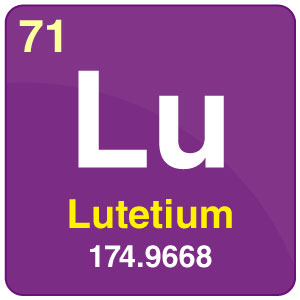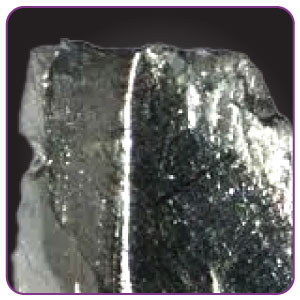Lutetium (Lu)

| Symbol | Lu |
| Atomic Number | 71 |
| Atomic Mass | 174.97 g.mol -1 |
| Discovered by | George Urbain in 1907 |

Chemical Properties of Lutetium
| Group | Lanthanides | Melting point | 1663°C, 3025°F, 1936 K |
| Period | 6 | Boiling point | 3402°C, 6156°F, 3675 K |
| Block | f | Density (g cm−3) | 9.84 |
| Atomic number | 71 | Relative atomic mass | 174.97 |
| State at 20°C | Solid | Key isotopes | 175Lu |
| Electron configuration | [Xe] 4f14 5d1 6S2 | CAS number | 7439-94-3 |
| ChemSpider ID | 22371 | ChemSpider is a free chemical database | |
What is Lutetium?
- Lutetium is a chemical element with the atomic number 71. It is never found as a pure metal in nature. This metal is artificially produced by the reduction process of LuCl3 by any of the alkaline metals. It appears silvery and white in colour. Lutetium is one of the hardest metals coming on the list of lanthanides. This metal is stable in nature. It also possesses high density as well as a high melting point. It burns at a temperature of about 150 °C forming its oxides.
- This metal reacts with the lightest halogens forming tri-halides, which are soluble in water.
Applications of Lutetium
Lutetium is known to be used for commercial purposes as it is considered to be an expensive metal.
- It is used in the manufacture of memory devices, especially for gadolinium gallium garnet as a dopant.
- It is used as a catalyst in the petroleum industry.
- This metal is widely used in the processes of hydrogenation, polymerization, and alkylation.
- It is used in the LED bulbs in the form of Phosphor.
- In the medical field, it is more useful in the targeted therapies to cure tumours.
Certain Facts About Lutetium
-
- Lutetium is considered to be one of the toxic metals. Hence inhalation of this compound is very dangerous as it might lead to fatal conditions.
- When Lutetium is heated, it leads to a substantial explosion.
- Contact with Lutetium can also cause some skin disorders.
Frequently Asked Questions – FAQs
Q1
What is the period number of lutetium?
The group number of lutetium is 6.
Q2
What is the electron configuration of lutetium?
The electron configuration of lutetium is [Xe] 4f14 5d1 6s2.
Q3
What is the atomic mass of the lutetium element?
The atomic mass of the lutetium element is 174.97 g/mol.
Q4
What is the atomic number of lutetium?
The atomic number of lutetium is 71.


Comments